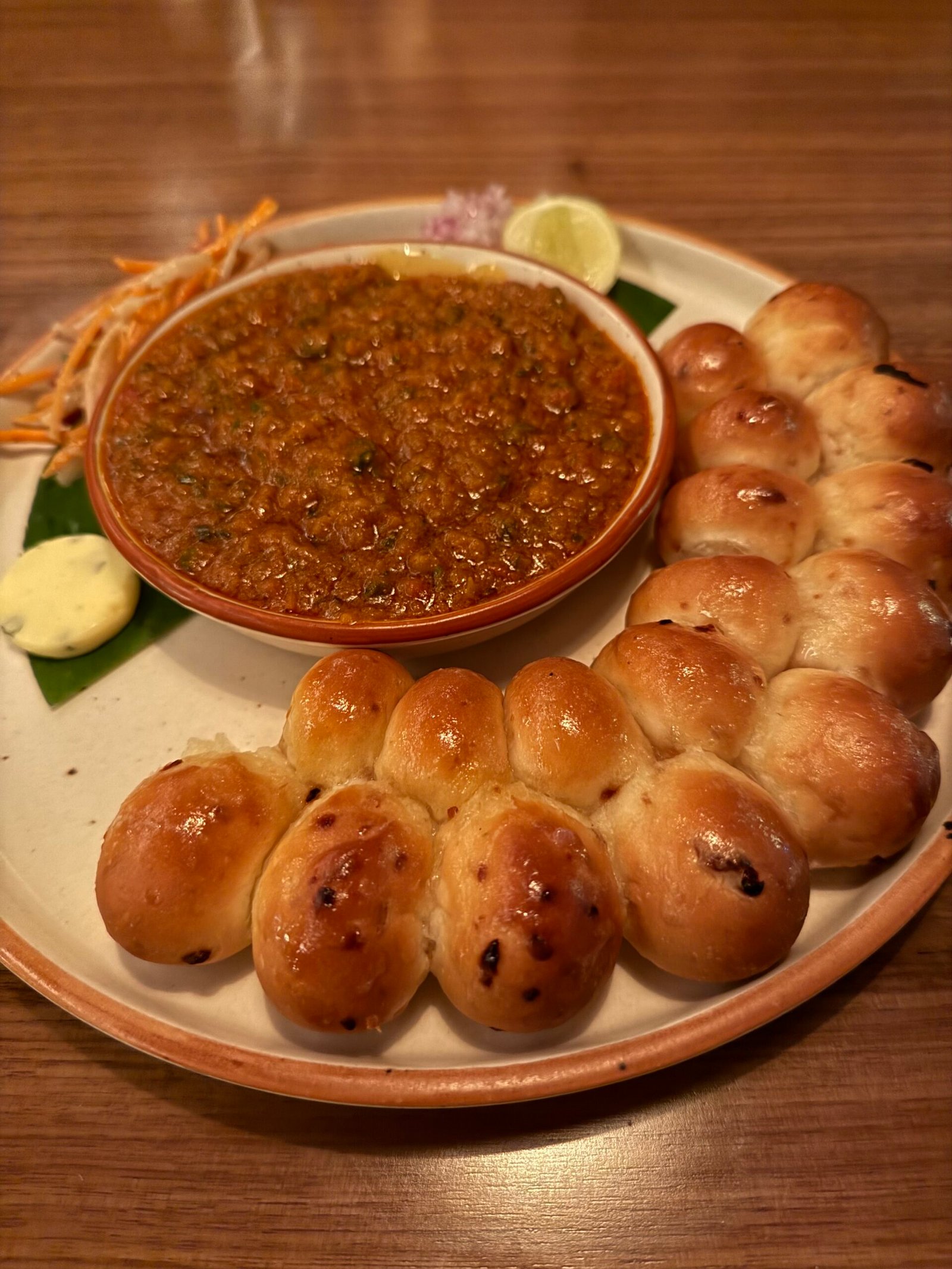K & I have a tradition of going out to dinner to celebrate happy moments in life. That’s how we decided to go to Comorin, Mumbai, the day before, as it was the blog’s 18th birthday.
A lot has changed over 18 years. We wouldn’t have gone to an Indian restaurant back then. Italian, Thai, Chinese, ‘Continental’, Japanese, a five-star hotel buffet perhaps (where we would head for the cold cuts), but not Indian. I am sure that we were not alone in our thinking. The Indian food scene has changed dramatically since then, and most of the restaurants in vogue today are Indian. These are very different from the posh Indian restaurants of yore. Today, celebrated chefs create tasting menus that incorporate innovative techniques and ingredients from across the country. The ambience of these places is internationally stylish, as are the prices. They dominate all restaurant lists and awards.

At the risk of sounding like a heretic, I must confess that such places don’t do it for me. I respect the creativity and skill displayed, the effort behind them, and how they have showcased Indian cuisine. The difference lies between appreciating classical music and swaying to a more earthy beat. I find tasting menus tiring. Literally. The food blurs together after the fifth course; all I can say when people ask about the experience is, ‘It was nice.’ I want food I can dive into and start eating without having to listen to an account of the dish’s genealogy. I hope I have not burnt bridges by writing this. I am fond of and proud of the chefs who run these restaurants. It’s just that I prefer masala movies to art cinema, if you get what I mean.

Now, what does my Trumpian digression have to do with Comorin?
Comorian is a recent addition to Mumbai; its original outpost is in Gurgaon. I have heard it being called ‘Gurgaon’s Bombay Canteen’ to explain the concept to locals. I suggested it to Kainaz, used the same analogy, and assured her it is not a tasting menu (she hates tasting menus, too). She agreed. The thing about us is that while Iget down and dirty when exploring Indian food, but what I call grunge eating isn’t for her. She has posher tastes. I keep this in mind while choosing places to eat.
We entered Comorin, located in what used to be K’s office complex during her time at JWT. We found ourselves in a stylish yet sophisticated setting, well lit (though not Instagram-worthy). Her only complaint was that the temperature was a little too cold. I agreed. We were guided to a booth at the end of the seating area. You were part of the restaurant, yet there was a sense of intimacy. We could hear each other speak, and we saw people across the tables happily chatting as they dug into their food. It was not one of those wildly loud places; it was a spot for grown-ups.

Chef Yash Raj
The young gentleman who attended to our table was friendly, knowledgeable, and shared his recommendations on what to order, but was not pushy. I ordered bheja masala and haleem, the latter being recommended by our friend Neville, a food fanatic. K chose achari beetroot, summer oranges, and tadka dahi to complement the meat. While we waited for our food, a young chef came out and introduced himself as Yash Raj, the restaurant’s head chef. He offered to send us half portions so we could sample other dishes. I eagerly accepted and ordered the chicken liver masala, which I had been eyeing. K firmly said she wanted a full plate of the salad. I couldn’t resist ordering the pav bhaji after seeing its picture in write-ups about the place. Chef explained that Comorin’s philosophy is to showcase India’s street food. I was sceptical. Could chefs in a ‘fancy’ place resist the temptation to reinterpret or re-engineer the food?
I soon ate my words and some splendid food. The dishes were brought to us swiftly and served with no fuss. We pounced on the food the moment I finished taking pictures.
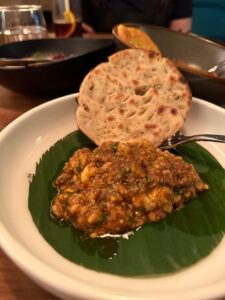
Bheja masala
The bheja masala and liver masala reminded me of Bohri Mohalla’s street carts in terms of spicing, texture, and the presence of ‘tari/rogan’ (oil). They were served on attractive Fab India meets Nicobar plates, not on boulders or bowls of rajma!
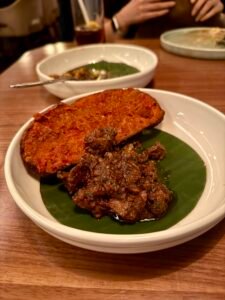
Kaleji fry/ chicken liver masala
The bheja masala was served with a lovely, crusty naan to scoop it up. A pav would have helped the masala soak in better, but this worked. The liver masala came with a tomato chilli sourdough, which was the only blemish in the meal. Its tomato base soaked the sourdough toast, making it limp, and clashed with the liver’s flavours. I set the bread aside and enjoyed the satisfying and hearty plate of offal on its own. I would definitely have served a pav with this.

Haleem
Comorin’s version of Hyderabad’s flagship dish of haleem (some might argue that biryani deserves that moniker) was truly sensuous. It was prepared with mutton, not beef, and broken wheat. It had the pasty and meaty texture of haleem. The flavouring was spot on, and it carried a pleasant aroma that I believe was saffron. It was topped with birista (fried onions) and served with Kashmiri beaker Bari bread. If the bheja and kaleji (liver) had strong street creds, this belonged to the kitchens of the Nizams.
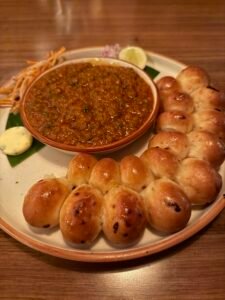
Pav bhaji
The pav bhaji was served with a flotilla of pull-apart, buttery, caramelised, and incredibly soft pavs. We asked for seconds. The bhaji bhaji reminded me of the one I get at Soam and that made by home chef Shital Kakad. Both are my favourite pav bhajis in town, apart from the one made by Ashok, who runs a cart at Fort. The bhaji here was wholesome, buttery, and tasty, but not very spicy. The only distinguishing feature was the sharp hit of tomato, which dominated the dish. I am conflicted about whether I like that or not. It would have fit well in a well-made bolognese or a marinara, rather than in the bhaji. That aside, this was a good-quality Mumbai pav bhaji.
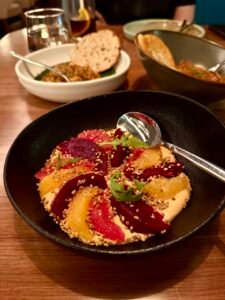
Beet and orange in dahi
It wasn’t all ‘hard core’ stuff; the Achari beetroot, orange in dahi with tarka, was sublime and provided a cooling relief in between. The presentation was attractive. The tadka added a subtle heat. The dahi batata puri served to us on the house had a slight chef-like touch. The puri was beautifully crunchy, the dahi and potato inside were soothing, and then came a hint of wasabi that made you go, ‘Whoa, what was that!’ It was nice, but I don’t think I could have managed two of those.
 Overall, Comorin delivered on its promise to respect and serve authentic from the streets of India. The atmosphere was refined enough for those who prefer to avoid more ‘massy’ places. This made it ideal for our date night. The prices seemed quite fair given the location, quality, service, and especially, the food, which emphasised comfort.
Overall, Comorin delivered on its promise to respect and serve authentic from the streets of India. The atmosphere was refined enough for those who prefer to avoid more ‘massy’ places. This made it ideal for our date night. The prices seemed quite fair given the location, quality, service, and especially, the food, which emphasised comfort.
Comorin makes it to my list of recommendations for Mumbai, and no, this was not a hosted meal.


